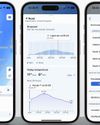
The first commercially available folding OLED smartphone was the Royole FlexPai, and it was absolutely terrible.
It seems as if 2020 will be the year of the fold and the roll. Motorola’s rebooted Razr phone comes with a foldable display and a price of around £1,500, while Samsung’s Galaxy Fold has a bigger screen and price tag: it’s £1,800. Both the screen and its price fade into insignificance next to LG’s OLED TV R9 – a 65-inch 4K TV that rolls away completely and will cost an estimated sixty thousand dollars.
How do you make a display that folds? With some difficulty. We’ve been promised flexible, foldable displays for years but it’s taken a long time for them to become practical. Part of that is because we had to wait for OLED.
OLED (Organic Light-Emitting Diode) displays differ from traditional LED displays because each pixel produces its own light. In non-OLED displays, the pixels don’t: LEDs produce a backlight which is projected through them and onto the screen, which is usually glass. Even the cleverest smartphone glass is not currently famed for its flexibility. Not only that, but the backlight would make things harder because it also has to flex – and it has to flex in a way that keeps the light to the pixels consistent. It turns out that trying to achieve that is a real pain in the glass.
OLED takes that pain away, because you can print the OLEDs onto a sheet of plastic – and plastic bends. The iPhone X used “innovative folding and circuit stacking technology” to bend the edges of its display into the corners and software to remove visual distortion – but only to a very limited extent.
This story is from the June 2020 edition of MacFormat UK.
Start your 7-day Magzter GOLD free trial to access thousands of curated premium stories, and 8,500+ magazines and newspapers.
Already a subscriber ? Sign In
This story is from the June 2020 edition of MacFormat UK.
Start your 7-day Magzter GOLD free trial to access thousands of curated premium stories, and 8,500+ magazines and newspapers.
Already a subscriber? Sign In

Rainbow Weather: AI Forecast
Need a mac? Check this app

Anker A1564 MagGo Power Bank (10K)
A pocket-sized portable charger for when you need it most

Logitech MX Brio
A champion of webcams in the darkness

TP-Link Archer Air R5/E5
A modern networking system for today’s home

1More Penta Driver P50
Who needs wireless earbuds when you can have these?

LaCie Rugged Mini SSD
Rugged external SSD storage

Synology BeeStation
Affordable network storage with Time Machine support

KEEP YOUR OLD MAC RUNNING
Get that Mac out of the attic and fire it up or you'll never know what it’s capable of!

CREATE YOUR DREAM SMART HOME
Make your semi smarter, your bungalow brighter or your flat future-proof with Siri and the best smart home tech

macOS
Shine a spotlight on the solutions to your most irritating Mac problems